Frills And Owls Pigeons Guide
In the world of pigeon breeding and training, one of the unique categories that you may come across is the pigeons labeled as frills pigeons and owl pigeons.
But what are frills and owls pigeons? Are they a different breed of pigeons that hails from a mix of frills and owls?
It can be confusing to understand what frills and owls pigeons are without thinking of them as different breeds.
In reality, frills and owls pigeons are just different types of pigeons that share some unique characteristics and appearance similar to frills and owls.
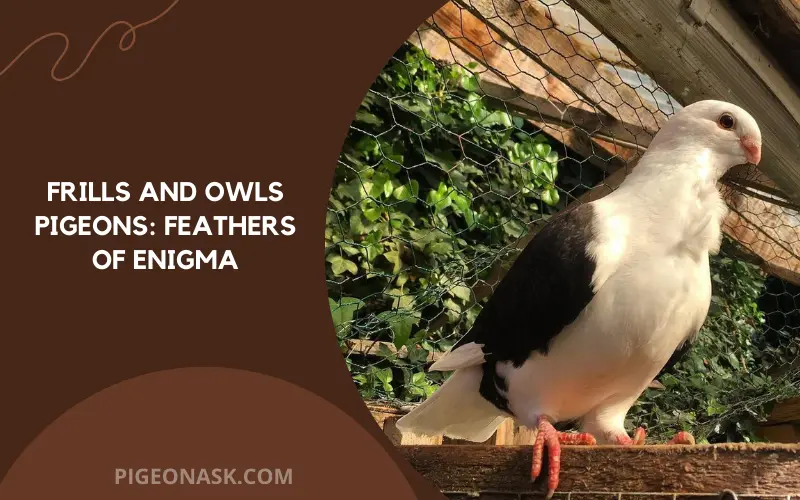
If you want to discover more about the characteristics, personality, behavior, and breeding details of these types of birds, then keep on reading, as we will cover every detail in the guide!
Looking for more articles about pigeon type:
Overview of Frills and Owls Pigeons
As mentioned earlier, frills and owls pigeons aren’t a completely new breed of pigeons. Instead, they are a subspecies category that shares similar features and characteristics with frills and owls.
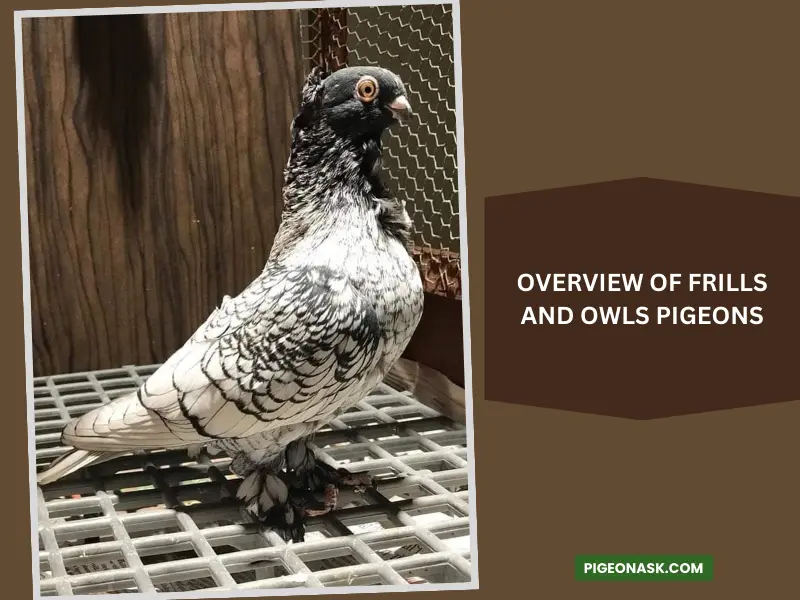
Frills Category
Pigeons that belong to this category comes with unique feather design structure and patterns that pay homage to a frilled outlook.
Owls Category
On the other hand, pigeons that are labeled as owls pigeons offer a facial structure similar to owls. This means they will have round shaped eyes and a head shape identical to owls but much smaller.
You can find quite a few species of pigeons that shares similarity with the mentioned categories, but the most popular and well-known ones are the following –
Frills and Owls Pigeons Category:
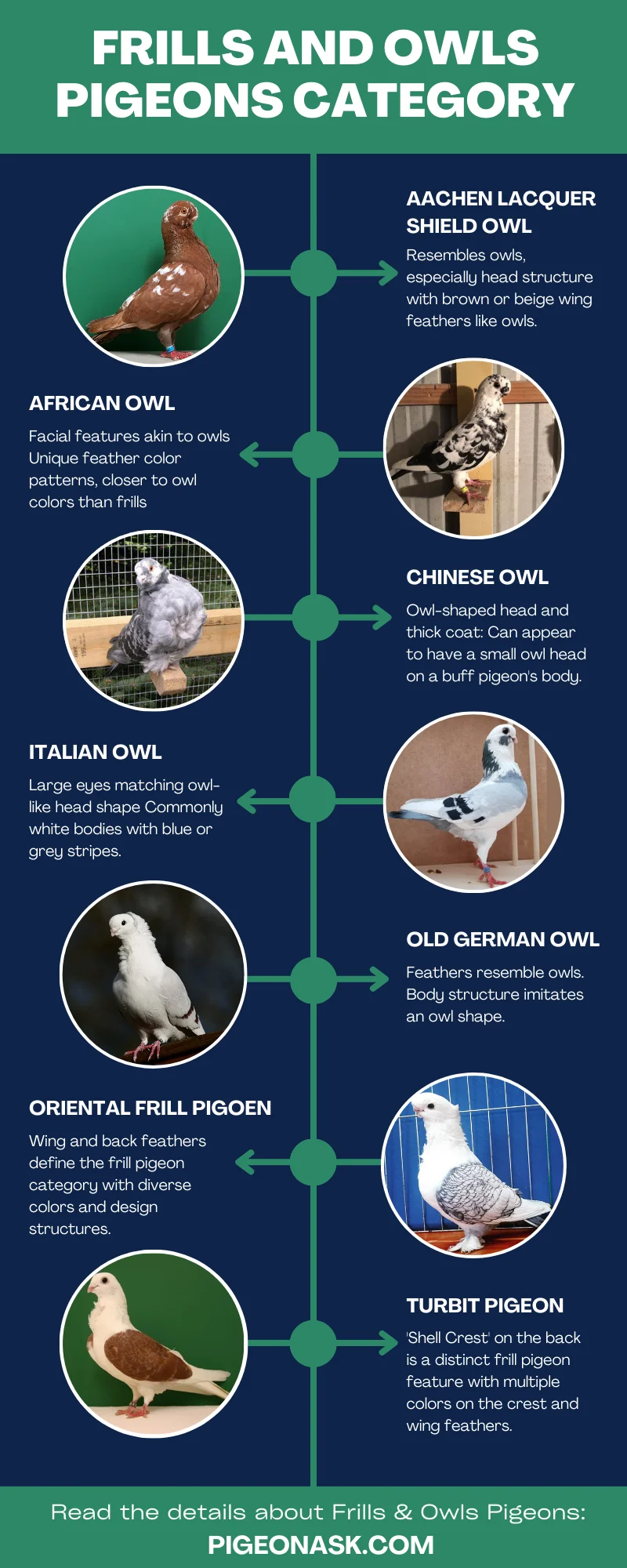
| Name | Category | Description |
|---|---|---|
| Aachen Lacquer Shield Owl | Owl Pigeon | Resembles owls, especially head structure with brown or beige wing feathers like owls. |
| African Owl | Owl Pigeon | Facial features akin to owls Unique feather color patterns, closer to owl colors than frills |
| Chinese Owl | Owl Pigeon | Owl-shaped head and thick coat: Can appear to have a small owl head on a buff pigeon’s body. |
| Italian Owl | Owl Pigeon | Large eyes matching owl-like head shape Commonly white bodies with blue or grey stripes. |
| Old German Owl | Owl Pigeon | Feathers resemble owls. Body structure imitates an owl shape. |
| Oriental Frill | Frill Pigeon | Wing and back feathers define the frill pigeon category with diverse colors and design structures. |
| Turbit Pigeon | Frill Pigeon | ‘Shell Crest’ on the back is a distinct frill pigeon feature with multiple colors on the crest and wing feathers. |
Common Physical Appearance and Unique Features
From the earlier table, you can easily see that some features of Frills and Owl pigeons are identical, while some are extremely unique.
Among owl pigeon, medium to slender body type and large rounded eyes with owl-shaped head is the most common.
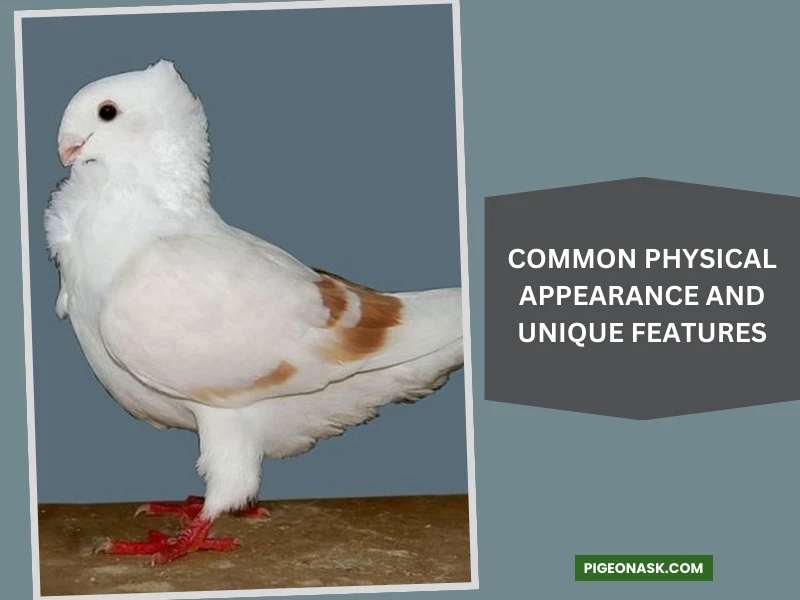
That being said, in some cases, like for the Old German Owl pigeon, it is not the head or the eyes but the feathers that make them owl pigeons.
On the other hand, frills are slenderer and smaller sized and are differentiated only due to their feather patterns. But the colors and patterns are different from one frill pigeon to the other, which makes them stand out even more.
Behavior And Personality
When it comes to behavior and overall personality, both frills and owl pigeons can be marked as one of the most easy-going pigeon species out there. They are mild-mannered and have shown coexisting capability with most birds.
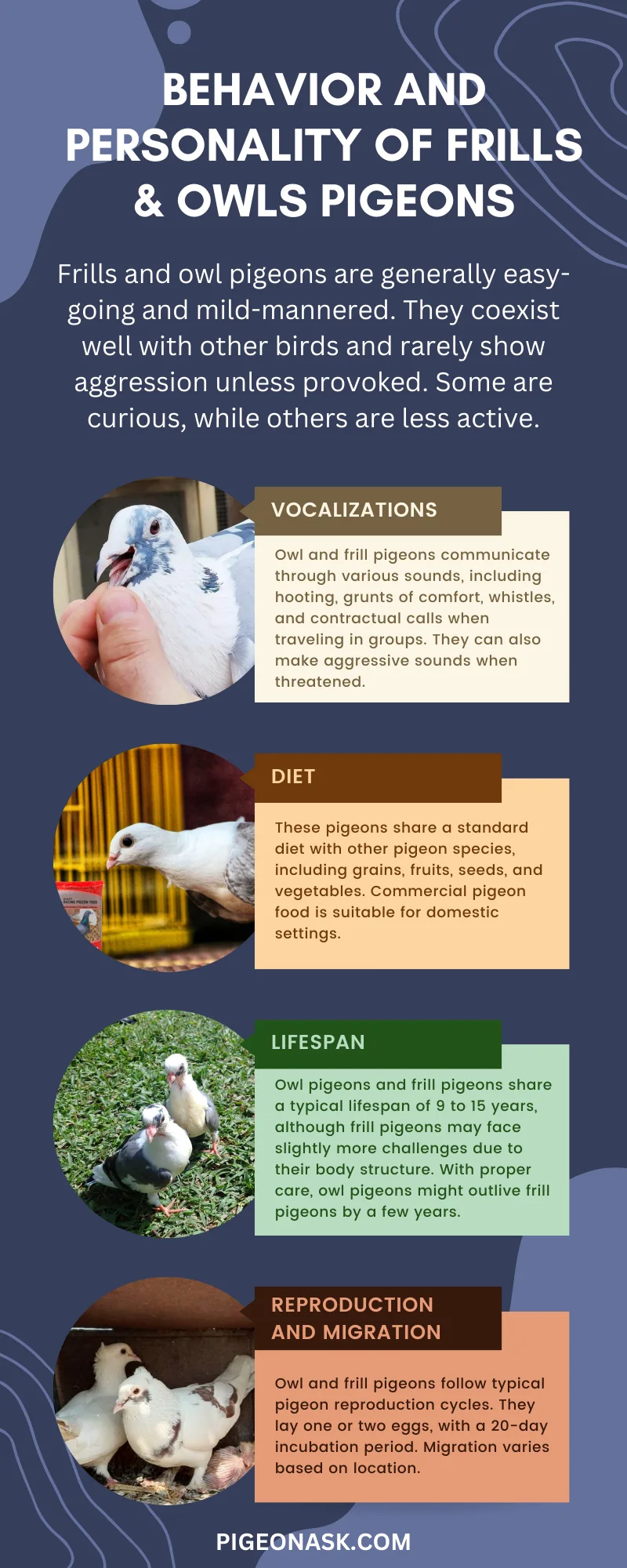
Almost all of them are timid in nature and won’t become aggressive unless you start to provoke them drastically. Some of them are curious, while others may not even bother to perch or sit unless they have to search for food.
Vocalizations
Similar to every other pigeon, owl and frill pigeons are also known for their wide range of calls and vocalizations. Some of the most noticeable ones are:
- Hooting or Cooling – This is the most common method of communication among them. They are rhythmic beats that are soft and can be very repetitive.
- Comfortable Grunts – This is heard when the pigeons are resting. They will let out grunting noises to show signs of approval and comfort.
- Whistles – Owl pigeons are also known for whistling from time to time. This behavior is noticed among African owl pigeons the most.
Apart from these calls, frills and owl pigeons can also make contractual calls, which they do if they are traveling in groups. There are also aggressive sounds that these birds make when they are faced with danger or attacking someone.
Diet
There aren’t any unique diets that these different types of pigeons follow that others don’t. They can survive on the standard diet of pigeons, like grains, fruits, seeds, and vegetables.
For those who want to raise them in a domestic setting, feeding them standard or commercial pigeon food is the ideal option.
Lifespan
The general lifespan of pigeons is between 9 to 15 years, and owl pigeons and frill pigeons share that same time as well.
In most cases, frill pigeons have it a bit rougher to survive in the world than owl pigeons due to their body structure. That is why, in some cases, owl pigeons tend to live a few years more than frill pigeons with proper care.
Reproduction and Migration
These birds follow a similar reproduction cycle and behavior to other pigeons. They start their mating season by courting and then finding a nest.
One or two eggs are usually the result and require an incubation period of around 20 days to hatch.
As for the migratory behavior, these birds can travel long distances to survive the winter in their area. The migration period will depend on the geographical location of these pigeons.
Geographic Distribution of These Breeds
If you want to encounter these pigeons firsthand, then you will have to go around the globe as they are scattered across the world.
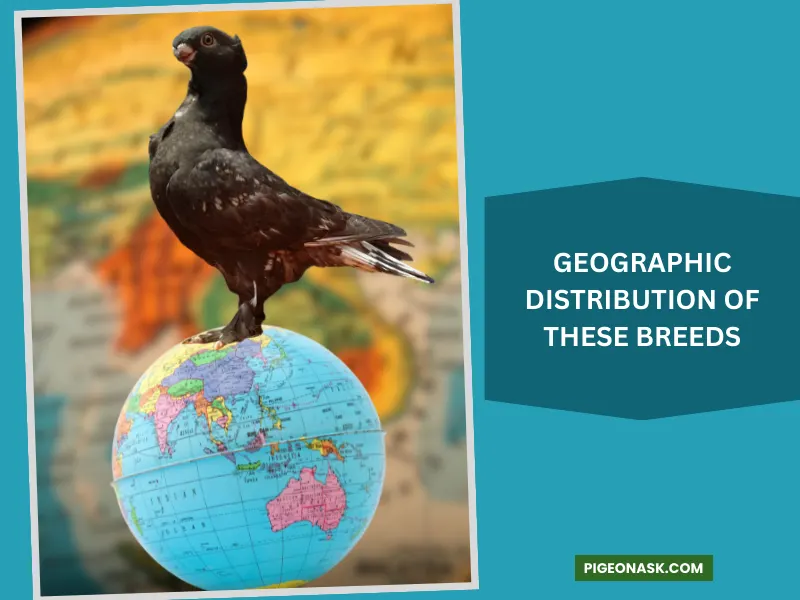
The owl pigeons can easily be found in the countries they are named after. While the frill pigeons can be a bit tricky to track down, they are usually found in Europe and some parts of Northern America.
The Popularity And Cultural Significance of Frills and Owls Pigeons
Both owl pigeons and frill pigeons are adored by people due to their unique design and friendly behavior. Some of them are quite important and hold a symbolic role to many.
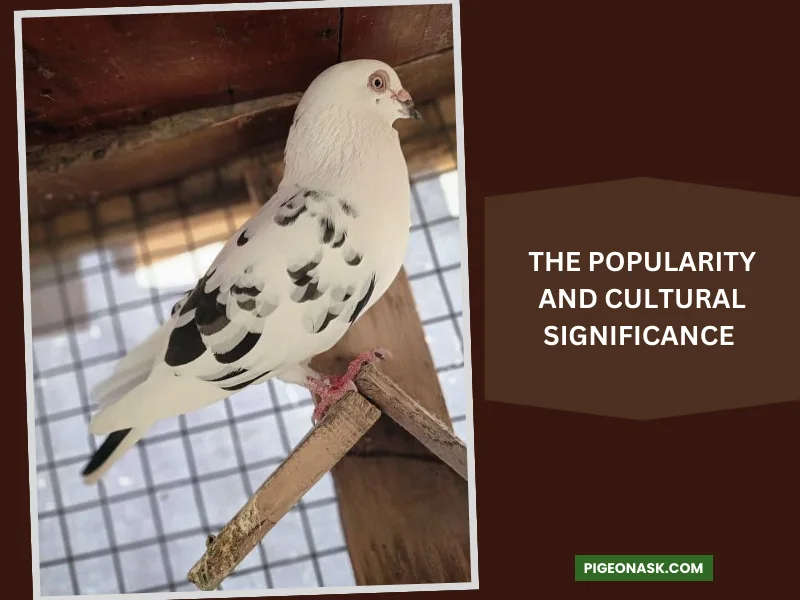
Traditional and Cultural Associations
Frill pigeons are recognized as living arts as their feather designs are not only unique but also eye-catching. That is why in some cultures, frill feathers are symbolic of beauty and artistic nature.
Owl pigeons also play a role in folklore symbolism, and their majestic outlook often works to bring in a touch of mystery and wisdom to events they are involved in.
Pigeon Shows and Competitions
Both of these two pigeon species have had their fair share of shows and competition. Frills are entered in beauty contests, while owls are often used in magic shows and showmanship.
Breeding And Care Tips for Frills And Owls Pigeons
Those of you who want to have your own frills and owls pigeons should ask one question themselves, ‘Can these pigeons be kept as indoor pets?’
As this species of pigeons are not only friendly towards humans but also have a mild manner, they are quite easy to keep as a pet if you are able to take care of them properly.
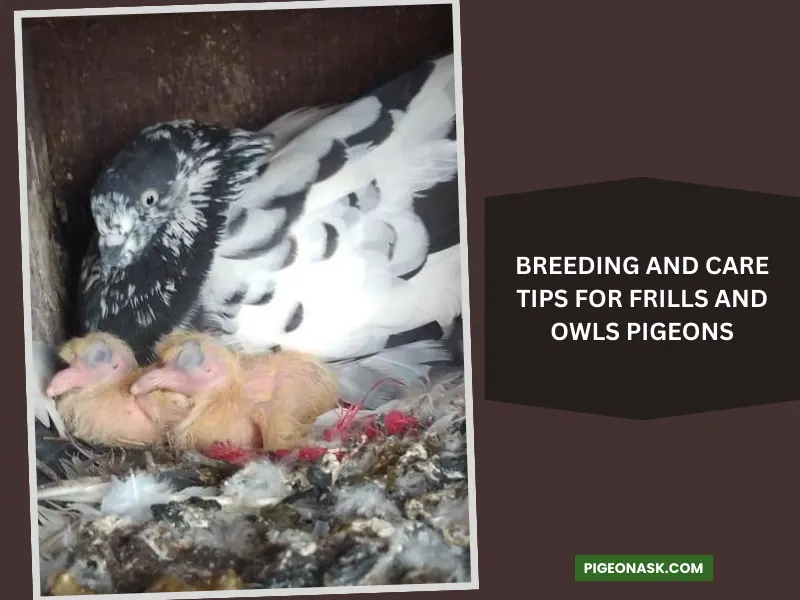
You can also teach them tricks if you are dedicated enough. Here are some tips that can help you to take care of these birds indoors:
- Keep them in a clean environment.
- Make sure to feed them on time and not over or underfeed the birds; breeding pairs should be a priority when setting the diet rules.
- Regular grooming and exercise are necessary, especially for frill pigeons.
- Pick healthy birds for breeding, ensure pair compatibility, and implement proper breeding management steps like monitoring the birds and looking out for incidents.
- Nesting boxes should be made with the egg care procedure in mind.
- Make sure not to overbreed; the mental state of the birds should also be accounted for.
Final Thoughts
Both frills and owl pigeons are unique species with unique features compared to others. They are also excellent companions to breed and train if you are willing to take the extra steps.
So, if you plan to breed them, then make sure to follow the proper caring process. Hopefully, this clears everything regarding these magnificent pigeons.
And if you want to learn more about them and want to see similar content, don’t forget to follow us on our Facebook, Pinterest, and Twitter pages.
